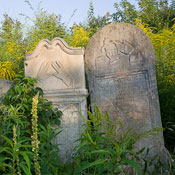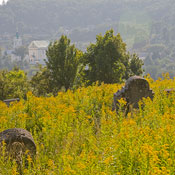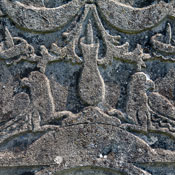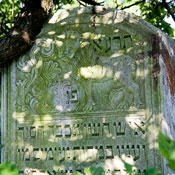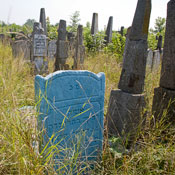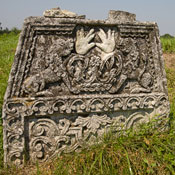




| ARCHITECTURE |
| DOCUMENTARY |
| clients |
| CONTACT |
| 212.228.8100 |
|
||||||||
Documentary Bet Hayyim - The House of Life I could see hundreds of stones jutting out of the hills in all directions, leaning this way and that like silent figures pushing out toward the sun. In the distance, the worn grey, beige and brown graves were stark monuments, reminders of the people who had lived out their lives in this place, and died. The cemeteries seemed to be swallowed up by nettles, wildflowers and hills of exuberant goldenrod. Where the ground had shifted, the displaced stones appeared as monoliths from some ancient civilization, left by time to lean against one another. In August 2008 I travelled to the Ukraine for the first time, to meet two of my friends and to visit Odessa, the birthplace of my father. My two-week visit became an exploration into the history of the once vast community of Eastern European Jews and the relics they had left behind. This odyssey started in Kiev at the ravine in Babi Yar, and took me to the tombs of Rabbi Nachman in Uman and the Ba’al Shem Tov in Medzhybizh, two historic Hasidic pilgrimage sites associated with the Kabbalah. I crisscrossed the heartland, over 2000 kilometers, to visit cities, towns, and shtetls, and to photograph the carved tombstones in cemeteries dating back to the 1400’s. Each site and stone had a story to tell. Although the only sound was the wind through the trees, I could feel murmuring voices from deep in the uneven ground. The thick bramble and late summer grasses tightened around my ankles as I said “excuse me” to the spirits where I walked. Each stone was an artistic treasure filled with iconographic beauty and mystery. I saw elaborate carvings and primitive drawings, many with animal motifs: lions, stags, eagles, dogs, hares, and such mythical creatures as winged griffins and unicorns. Other friezes depicted symbols of lineage and gender. The pitcher pouring water represented the tribe of Levites, the assistants to the priests. The Cohens, descendants of the Biblical priests, had two hands joined in a spread-fingered gesture of blessing. There were hundreds of intricate candelabra images marking the graves of women whose duty it was to light the Sabbath candles. Generosity was symbolized by hands giving out coins, while a learned person might have a book or a crown, the symbol of the Torah. Some epitaphs were intricately carved, the stones decorated in an elaborate Jewish script covering the entire surface; others held only the most minimal outline of the Star of David. Massive, six-foot-high sculptures of tree trunks with their branches cut off towered over the simpler stones. Some retained a residue of ochre and blue paint, (perhaps the final touch of the engravers and stonecutters), while others were covered only in lichen and moss. The Bet Hayyim that survived the destruction of the pogroms and the murder of the local Jewish community during the Holocaust have been abandoned to the elements for more than half a century. Yet these “houses of the living” powerfully remind us of the centuries of life, art and ritual which thrived here. For me, a first-generation American, an artist, a photojournalist, and a historical preservation photographer, they have become a portal to rediscovering my own Jewish heritage. |
©2008 TRIX ROSEN PHOTOGRAPHY LTD
| THE UKRAINE | BURMA | THE PHILIPPINES | InSIGHT OUT! |
